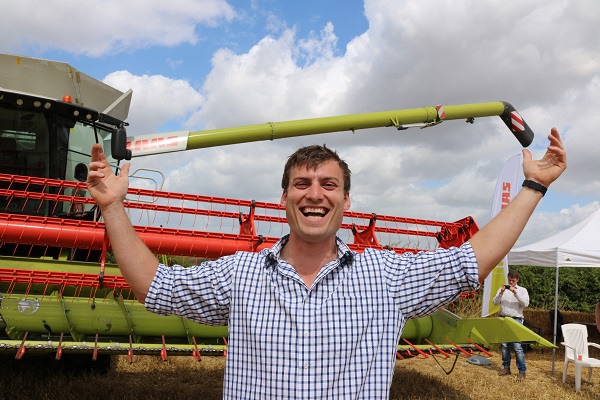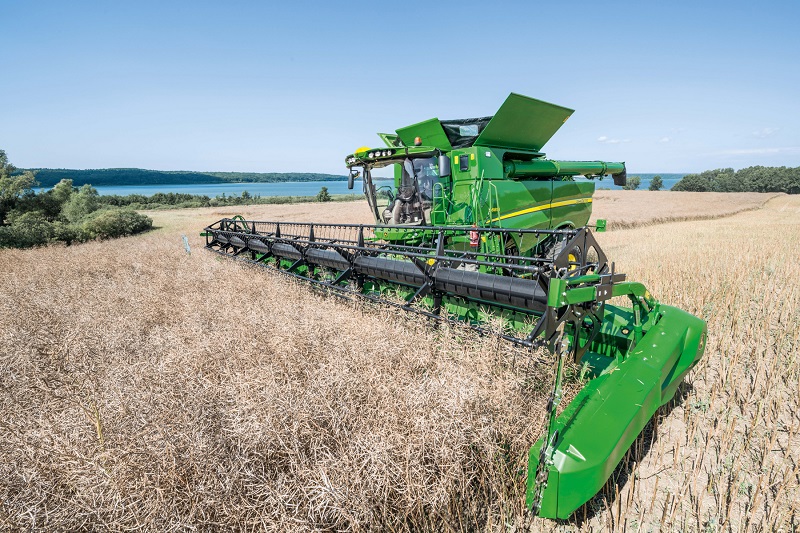There are small changes in the combine line-up for 2017 that add up to big productivity benefits. CPM finds out what the main manufacturers are offering in place of the UK’s aging harvester hulks.
The new model still boasts a harvesting throughput of more than 50t of wheat/hr
By Tom Allen-Stevens
With the number of new combines sold in the UK having sunk to nearly half what it was at its peak, it’s not surprising that flash new models are a little thin on the ground.
That’s not to say that manufacturers aren’t innovating, however. Dig a little deeper into the tweaks and tucks they’ve made in their latest ranges and you’ll find some remarkable and quite irresistible features, once preserved for the premium models, are creeping into the more standard machines.
Tucked-in technology
Making its UK debut during New Holland’s harvest demonstration tour during Aug and Sept is the company’s new narrow-bodied CR8.80. The latest model in its rotary combine line up, there’s a new engine which meets Tier 4B emissions criteria and adjustable vanes to improve grain separation.

The CR8.80 treads a narrower path, but comes equipped with many of the same features as can be found in the range-topping CR10.90.
The CR8.80’s new FPT Cursor 11 engine brings it in line with the rest of the CR range, with EcoBlue emissions technology meaning no
requirements for engine gas recirculation (EGR). The result is high efficiency while remaining responsive when running under full load for long periods, says New Holland.
Redesigned adjustable vanes have been added and help improve power efficiency and increase grain separation. Already in use on larger CR models, the vanes sit on the top section of the rotor cage and help to keep the crop on the rotor for longer. Improved centrifugal threshing removes more grain from the straw mat, improving performance when working with damper straw more common in UK crops.
When shod with tall 710/70 R42 tyres or 24-inch tracks, the CR8.80 treads a narrower path through traffic and gateways at 3.24m wide. But the new model still boasts a harvesting throughput of more than 50t of wheat/hr when fitted with a 9.1m Varifeed table. It also features the same Twin Pitch Rotor technology and Dynamic Feed Roll module as can be found in the range-topping CR10.90.
“The advantage of the Twin Pitch Rotor is that it’s really gentle on straw but produces very good results,” says New Holland’s Nigel Honeyman. “The Dynamic Feed Roll makes for a smoother crop flow. This machine is an excellent choice for those considering the move from straw-walker to rotary combine.”
Straw-walker shine
Following Claas’ upgrade of its Lexion 700 series last year, the 600 straw-walker range receives a facelift in time for the 2017 season. There’s a new engine, straw chopper and the refreshed range picks up a number of other features previously only available on the higher capacity range.

The Lexion 700’s new whopping 7XL grain auger reaches a full 12m for those heading down the CTF route, says Adam Hayward.
Power’s now provided by a 7.7-litre or 10.7-litre Mercedes-Benz T4F compliant engine, putting out 313hp on the 620, up to 435hp of grunt through the flagship 670. The 660 and 670 have Claas’ Dynamic Cooling system, that automatically adjusts cooling, drawing clean air from above the combine, while dust is ejected in a skirt around the sides. This helps save up to 20hp, says the manufacturer.
Auto Crop Flow control, developed for the 700 range, is now available on the 600 series. “This option has proved very popular, with 85% of new 700s sold with it,” says Adam Hayward of Claas. Sensors monitor engine speed, the APS and impellor drum and straw chopper, alerting the driver to any potential blockage. “It gives the operator the confidence to push the machine to its maximum capacity.”
Auto Slope control adjusts fan speed on uneven terrain, and the 600 series is now available with Claas’ Cemos automatic cleaning, that sets the grain cleaning system to produce the optimum sample.
Another addition to the 660 and 670 is the option of Terra Tracs. “Operators like the ride on the road, and say it makes the machine more stable, while it spreads the weight better and keeps transport width down,” notes Adam Hayward.
At the back, there’s a new straw chopper and radial spreader. “The drum width is larger so crop flow is more uniform. Blade diameter has increased so there’s larger tip exposure – a large volume of straw and chaff can be accommodated and it’s accelerated to a higher speed, improving residue spread.”
The big news on the Lexion 700 Hybrid range is the new 7XL grain auger that puts an extra-long unloading auger on the high-capacity machine for those heading down the Controlled Traffic Farming (CTF) route. The whopping 12m auger matches the Vario 1230 cutterbar and is only available on Terra Trac models which have been fitted with a reinforced 13,500 or 11,500-litre grain tank. There’s a folding 2.11m long end-piece that wraps around the back of the combine for transport and keeps the combine to a sensible length.
Header contol
From 2017, John Deere will be replacing the existing 300R cutting platforms on all W400 Series combines with 600R headers. These have a larger diameter intake auger and feed plates, providing a better feeding capacity.
Meanwhile, the W330 combine will feature two new options for 2017. A distance height-control system allows the operator to save a headland setting and a field cutting-height position, which can be quickly resumed after turning at the headland. Alongside this, automatic header-control ensures that the cutting-platform height follows ground contours and cutting height is more consistent.
All John Deere S-Series combines for 2017 will feature the new DynaFlo Plus aluminum cleaning shoe, which has been increased in length by 12%. There’s a new airflow concept and redesigned fan, which means the shoe is less sensitive and easier to adjust, with the result that tailing volumes have t been reduced by up to 28% for larger grains.
The new active terrain adjustment (ATA) option alters the cleaning shoe chaffer, sieve and fan in rolling terrain. This opens or closes the chaffer and sieves and adjusts fan speed, when travelling up and down slopes, resulting in a productivity lift of up to 30% and reduced tailings of up to 50%, says John Deere. It also takes into account the type of grain being harvested, making the changes to fan and chaffer settings accordingly.
An optional 40km/h transport speed and engine speed management will now be available on the S680, S685 and S690 combines in addition to the S670, T560 to T670 and W660 models.
Mid-range might
There have been a number of minor tweaks to improve Massey Ferguson’s Activa S and Beta combine harvesters. “These harvesters are proving particularly popular among farms looking for an efficient and cost effective combine to secure their own harvests,” says MF’s Adam Sherriff.
The Activa S combines have a 7.4-litre Agco Power engine chunting out a maximum power of 243hp on the Activa 7345, while a 30hp boost for unloading takes the 276hp max power to 306hp on the Activa 7347.
Both MF Activa S combines are available with the Multi Crop Separator (MCS), claimed to provide enhanced threshing while remaining gentle on the straw. Engaged electrically, this passes the crop through the threshing cylinder to an additional drum and concave system providing up to 1.07m² of extra separating area.
The Activa S boasts the Proline cab, developed specifically for these machines, that incorporates the TechTouch 2 terminal. “It provides features such as self-setting and automatic reel speed, but it’s not overly complex,” adds Adam Sherriff.
The MF Beta 7300 Series combines are powered by six-cylinder Agco Power engines, with the 320hp, 8.4-litre capacity version in the MF 7370 and PL models developing 30hp of extra power for unloading, while there’s a 7.4-litre engine, generating 276hp, on the MF 7360.
AutoGuide XLS automatic steering provides accuracy down to 5cm, while MF’s ParaLevel front-axle system offers automatic side-to-side levelling across slopes of up to 20%. The Integrale option to PL combines provides complete levelling, which raises and lowers the rear of the machine to compensate for working on slopes of up to 30% uphill and 10% downhill.
The Activa S and Beta models have drum and concave threshing with straw-walker separation, and all models can be specified with MF’s PowerFlow header, which is available in widths up to 6.8m for the Activa S and 7.7m for the Beta combines.
Axial-Flow goes for Redekop chop
Case IH Axial-Flow 240 series combines have a new chopper option for 2017. The manufacturer’s working with Canadian firm Redekop to bring its MAV (Maximum Air Velocity) straw chopper design to the UK market.
The new package creates a finer chop and more even spread of straw, leading to faster decomposition and incorporation into the soil, says Case IH. The move follows two years of UK trials to ensure the set-up’s suitability for UK conditions. The Xtra-Chopping package will be an option for the flagship 240 series Axial-Flow models and can be retro-fitted to existing 230 and 240 series combines.
Xtra-Chopping retains the existing integral two-speed Case IH Magna-Cut 120-blade chopper. This is used as a discharge beater to pre-chop residue and propel it into the hood-mounted Redekop MAV chopper. The Xtra-Chopping is controlled via the combine’s AFS Pro 700 terminal.
The design features 12-blade paddle fans at each end of the chopper rotor. These generate maximum airflow velocities of up to 90mph which draws both the straw and the chaff through the chopper as it’s ejected from the rear of the rotor, explains Paul Freeman of Case IH.
“Air is scavenged from the cleaning shoe, drawing the chaff into the chopper so it’s mixed and distributed with the chopped straw. This airflow also helps present the straw lengthways to the 96 blades that are mounted in eight rows on the rotor. These operate at 3250rpm against an adjustable counter-knife, helping to slice the straw longitudinally as well as conventionally.”
The paddle blades help blow the finely-chopped material into the stubble across the full width of cut, he says, while splitting the stems lengthways as well as crossways allows moisture and natural soil bacteria to get at the straw and break it down more quickly.




